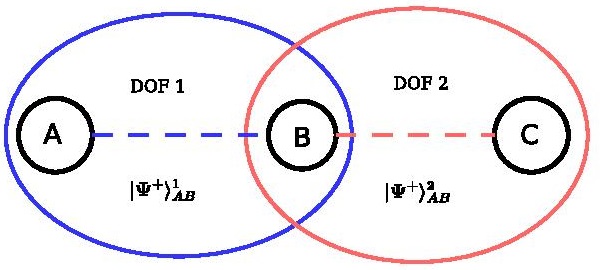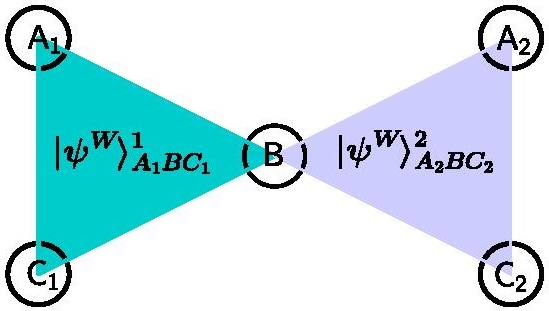Quantum information processing lies at the intersection of Information theory, Quantum mechanics and signal processing. In recent times, scientists are beginning to account for quantum effects in order to store, process and communicate information. A striking feature of quantum mechanics is the principle of superposition that has no classical counterpart. Another feature that catches attention of everyone working in the area of quantum mechanics is the phenomenon of entanglement. Feynmann said that “Entanglement is characteristic trait of quantum mechanics”. Ever since the discovery of super dense coding by Bennett and Wiesner, entanglement is being pursued as an important resource.
At PNSIL, we work on fundamental problems of communication that make use of entanglement. We are interested in understanding the structure of entanglement and how it can be put to use to perform tasks impossible in the classical world.

Figure 1: Bipartite entanglement over different degrees of freedom

Figure 2: Tripartite entanglement over different degrees of freedom
Sponsor
- Ministry of Electronics & Information Technology, India.
Collaborators
- R.P. Singh, PRL, Ahmedabad, India
- Bane Vasic, University of Arizona
Journal Publications
- A. K. Sharma and S. S. Garani, “Entanglement-assisted fault-tolerant encoding and decoding for qudit stabilizer codes,” in Physical Review A, Dec 2024.
- A. K. Sharma and S. S. Garani, “Near-Threshold Qudit Stabilizer Codes with Efficient Encoding Circuits for Magic State Distillation,” in Physical Review A, May 2024. An erratum of this paper is also published as ‘A. K. Sharma and S. S. Garani, “Erratum: Near-Threshold Qudit Stabilizer Codes with Efficient Encoding Circuits for Magic State Distillation,” in Physical Review A, Oct. 2024.’
- P. J. Nadkarni, P. Jayakumar, A. Behera, and S. S. Garani, “Entanglement-assisted Quantum Reed-Muller Tensor Product Codes,” in Quantum, vol. 8, May. 2024.
- S. S. Garani, P. J. Nadkarni, and A. Raina, “Theory Behind Quantum Error Correcting Codes: An Overview”, in Jour. Ind. Inst. Sci., July 2023.
- M. G. Majumdar and S. S. Garani, “Quantum network recovery from multinode failure using network encoding with GHZ states on higher-order butterfly networks”,Quant.Inf. Proc., doi:10.1007/s11128-021-03350-3, November 2021.
- P. J. Nadkarni and S. S. Garani, “Optimal Interleavers for Classical and Quantum Tensor Product Codes,” IEEE Communications Letters, vol. 25, no. 11, pp. 3478-3482, November 2021, DOI: 10.1109/LCOMM.2021.3110236.
- P. J. Nadkarni and S. S. Garani, “Non-binary Entanglement-assisted Stabilizer Codes,” Quant.Inf. Proc., vol. 20, no. 8, article 256, August 2021.
- P. J. Nadkarni and S. S. Garani, “Fp Linear and Fpm -Linear Qudit Codes From Dual-Containing Classical Codes,” in IEEE Trans. on Quantum Eng., vol. 2, article. 2101819, pp. 1-19, May 2021.
- P. J. Nadkarni and S. S. Garani, “Quantum error correction architecture for qudit stabilizer codes,” in Physical Review A, vol. 103, no. 4, article 042420, Apr. 2021.
- P. J. Nadkarni and S. S. Garani, “Entanglement-assisted Reed-Solomon Codes over Qudits: Theory and Architecture’,’ Quant. Inf. Proc., vol. 20, no. 4, article 129, April 2021, DOI: 10.1007/s11128-021-03028-w.
- P. J. Nadkarni and S. S. Garani, “Encoding of Nonbinary Entanglement-Unassisted and Assisted Stabilizer Codes,” in IEEE Trans. on Quantum Eng., vol. 2, pp. 1-22, article 2100322, Jan. 2021, DOI: 10.1109/TQE.2021.3050848.
- P. J. Nadkarni, A. Raina, and S. S. Garani, “Modified graph-state codes for single-node recovery in quantum distributed storage,” in Physical Review A, vol. 102, no. 6, article 62430, Dec. 2020, doi: 10.1103/PhysRevA.102.062430.
- P. J. Nadkarni and S. S. Garani, “Coding Analog of Superadditivity Using Entanglement-Assisted Quantum Tensor Product Codes Over Fpk,” in IEEE Trans. on Quantum Eng., vol. 1, pp. 1-17, 2020, article 2101417, doi: 10.1109/TQE.2020.3027035. (Listed in the front panel of the journal portal)
- A. Raina and S. S. Garani, “Quantum channels over graph states using generalized measurement-based quantum computation framework,” Quantum Info. Proc. vol. 19, article 94, Feb. 2020.
- A. Raina, P. J. Nadkarni, and S. S. Garani, “Recovery of quantum information from a node failure in a graph,” Quantum Info. Proc., vol. 19, article 70, Feb. 2020.
- A. Raina and S. S. Garani, “Recovery from an eavesdropping attack on a qubit of a graph state,” Quantum Info. Proc., vol. 18, no. 9, article 274, Sep. 2019.
Conferences
- P. Kumar, A. K. Sharma and S. S. Garani, “Entanglement-assisted Quasi-cyclic LDPC codes,” accepted in IEEE Information Theory Workshop (ITW 2024), Shenzhen, China, Nov. 2024.
- S. K. Sahoo, A. Raina and S. S. Garani, “Purification and Fidelity Enhancement from Quantum Mixedness,” in IEEE Intl. Conf. on Quantum Communications, Networking, and Computing (QCNC 2024), Kanazawa, Japan, July 2024.
- A. Muraleedharan and S. S. Garani, “Conditions for Quantum Network Teleportation,” in IEEE Intl. Conf. on Quantum Communications, Networking, and Computing (QCNC 2024), Kanazawa, Japan, July 2024.
- A. K. Sharma and S. S. Garani, “Fault-Tolerant Quantum LDPC Encoders,” in IEEE Intl. Symp. Info. Theory, Athens, July 2024.
- A. K. Sharma and S. S. Garani, “Magic State Distillation from Qudit Stabilizer Codes,” in IEEE Int. Conf. Comm., Denver, June 2024.
- P. J. Nadkarni and S. S. Garani, “Photonic Architecture of Entanglement Assisted Binary Quantum Tensor Product Codes,” in Frontier in Optics, Washington D.C., Sep. 2019.
- P. J. Nadkarni and S. S. Garani, “Entanglement Assisted Quantum Reed-Solomon Codes,” in Information Theory and Applications Workshop 2019, San Diego, February 2019.
- P. J. Nadkarni and S. S. Garani, “Encoding of quantum stabilizer codes over qudits with d = pk ” in Quantum Communication and Information Technology Workshop, IEEE GLOBECOM, Abu Dhabi, December 2018.
- P. J. Nadkarni, A. Raina and S. S. Garani, “Recovery of distributed quantum information from a node failure using graph states,” in Quantum Communication and Information Technology Workshop, IEEE GLOBECOM, Singapore, December 2017.
- P. J. Nadkarni and S. S. Garani, “Entanglement Assisted Binary Quantum Tensor Product Codes,” in IEEE Inf. Theory Work., Kaohsiung, Taiwan, Nov. 2017.
- A. Raina, P. J. Nadkarni and S. S. Garani, “Recovery of Distributed Quantum Information in Quantum Networks,” in Frontiers in Optics, Washington D.C., Sep. 2017.
- N. Raveendran, P. J. Nadkarni, S. S. Garani and B. Vasic, “Stochastic Resonance Decoding for Quantum LDPC Codes,” in IEEE Intl. Conf. Comm., Paris, France, May 2017.
- A. Raina and S. S. Garani, “Multiparty Quantum Communication Using Hyperentangled States,” in Quantum Communication and Information Technology workshop, IEEE GLOBECOM, Washington D.C, December 2016.
- A. Raina and S. G. Srinivasa, “Entanglement and its Role on the Capacity of Two-Pauli Channels,” in IEEE Workshop on Recent Advances in Photonics (WRAP), Bengaluru, December 2015.
- A. Raina and S. G. Srinivasa,” Eavesdropping on a Quantum Channel with a Unitarily Interacting Probe,” in Quantum communication and Information Technology Workshop, IEEE GLOBECOM, San Diego, December 2015.
- A. Raina and S. G. Srinivasa, “Quantum Teleportation Over Hyper Entangled States,” Info. Theory and Applications Workshop (ITA), Feb. 2015.
- A. Raina and S. G. Srinivasa, “Quantum Communication Over Bit Flip Channels Using Entangled Bipartite and Tripartite States,” In 52nd Annual Allerton Conference on Communication, Control and Computing, October 2014.